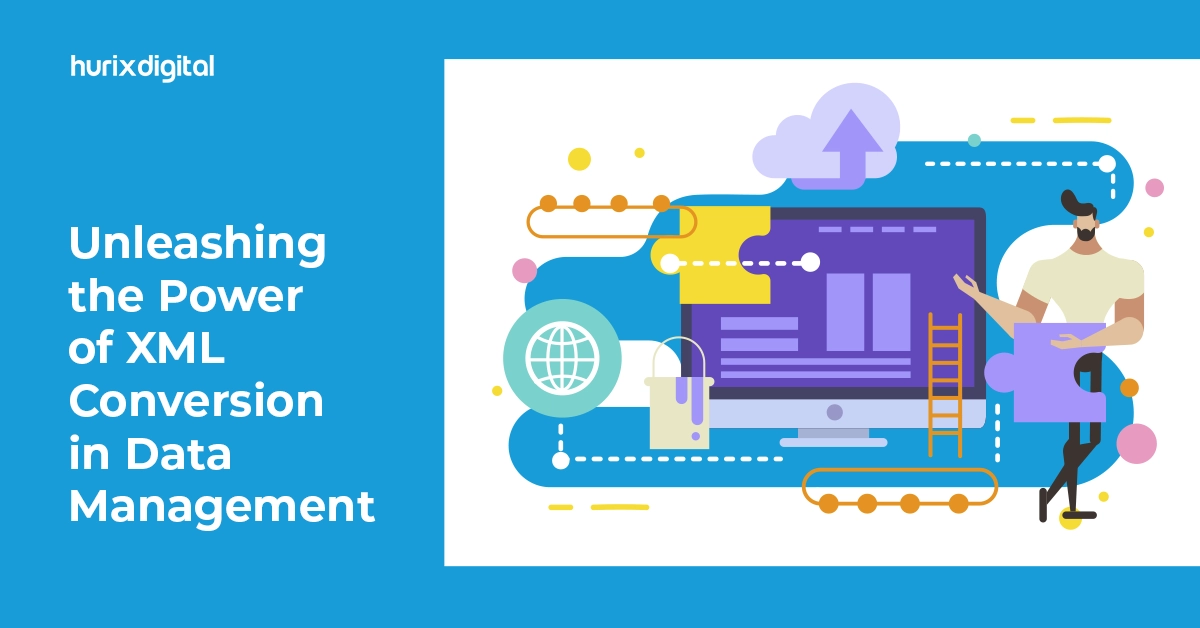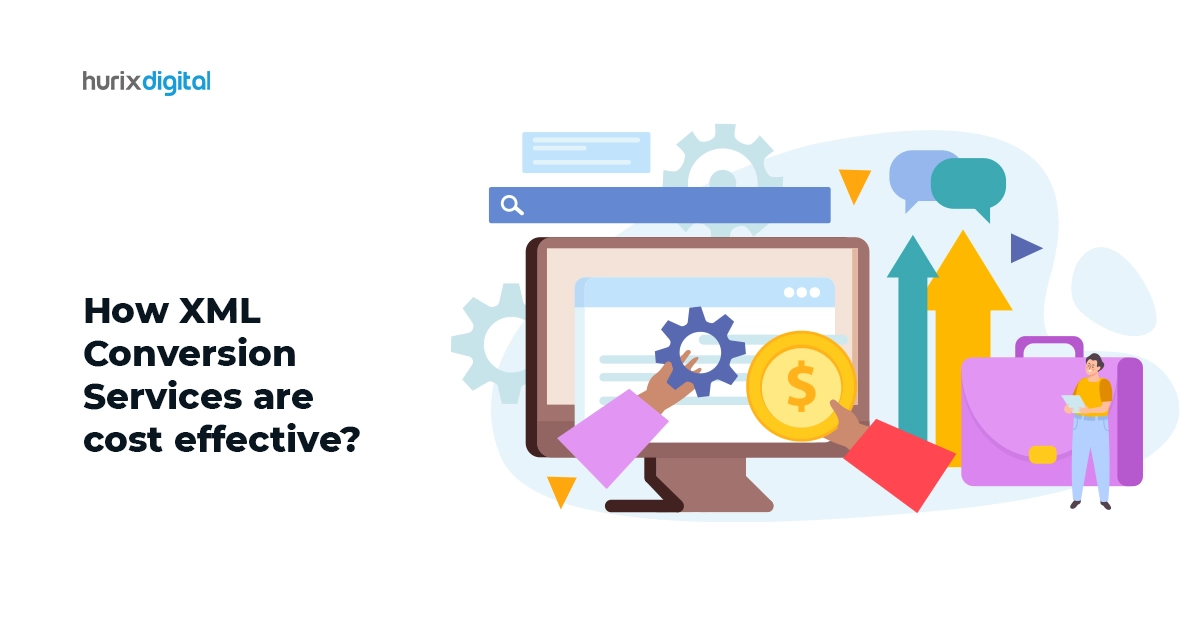Summary
This article establishes XML’s enduring value in harmonizing data despite disruptions through its inherently portable and adaptable nature - making it the practical choice to uplift legacy insulation towards readiness for AI/ML applications, CC publishing etc. via format change.
In the rapidly evolving landscape of data management, businesses are constantly seeking efficient solutions to handle large volumes of information effectively. One such solution that has gained prominence is XML conversion. This article delves into the transformative power of XML conversion in data management, highlighting its importance, benefits, and applications.
Table of Contents:
- XML Conversion: Enhancing Data Management Efficiency
- Why XML Appeals for Modern Data Environments
- Benefits of XML Conversion in Data Management
- When XML Conversion Accelerates Data Flows
- Unlocking the Potential of XML Processing
- Partnering with Hurix Digital for Expert Solutions
- Conclusion
XML Conversion: Enhancing Data Management Efficiency
XML (eXtensible Markup Language) is a versatile format used for structuring and storing data in a hierarchical format. XML conversion involves the process of transforming data from various formats into XML format, making it easier to manage, store, and retrieve. This conversion plays a crucial role in streamlining data management processes, facilitating seamless integration, and ensuring data accessibility across different platforms.
Let’s explore how “XML Conversion” capabilities actively shape the present and future of flexible yet robust “Data Management”!
Why XML Appeals for Modern Data Environments
As opposed to rigid tabulated data models, XML constitutes divisible, reconfigurable building blocks carrying self-descriptive structural and hierarchy information natively.
This malleability manifests multifaceted advantages:
➡️ Customizable Organization: Element descriptors allow programmatic restructuring attuned to consumption needs unlike fixed field CSV records.
➡️ Readability Across Systems: Being hardware/software agnostic, XML ensures interoperability even with legacy apps unlike proprietary formats.
➡️ Layered Enrichment: Additional metadata can be injected without tampering source data integrity.
➡️ Compact Transmission: Size economy despite descriptive markup facilitates web transfers unlike bloated proprietary document models.
Together this blend underpins XML durability despite data model flux reshaping data science preferences.
Also Read: A Beginner’s Guide to XML Content Development
Benefits of XML Conversion in Data Management
- Structured Data Storage: XML conversion enables data to be organized in a structured format, making it easier to categorize and retrieve information. This structured approach enhances data organization and simplifies data management tasks.
- Interoperability: XML is widely recognized as a standard format for data interchange, allowing for seamless integration with different systems and platforms. By converting data into XML format, businesses can achieve greater interoperability, enabling smooth data exchange and integration.
- Data Accessibility: XML conversion enhances data accessibility by providing a standardized format that can be easily interpreted by both humans and machines. This accessibility ensures that data is readily available for analysis, reporting, and decision-making processes.
- Data Integration: XML serves as a bridge between disparate systems and applications, facilitating data integration across different platforms. Through XML conversion, businesses can consolidate data from multiple sources, enabling a unified view of information and enhancing decision-making capabilities.
- Efficient Data Formatting: XML offers flexible formatting options, allowing businesses to define custom data structures and schemas tailored to their specific requirements. This flexibility enables efficient data formatting, ensuring that information is presented in a clear and consistent manner.
- Document Conversion Services: In addition to data conversion, XML conversion also encompasses document conversion services, where documents are converted into XML format for improved accessibility and compatibility. This service is particularly beneficial for organizations dealing with large volumes of documents, such as legal firms, publishing houses, and government agencies.
Also Read: Unlocking the Potential of XML: 5 Ways It Can Transform Your Workflow
When XML Conversion Accelerates Data Flows
While newer data representations grab mindshare, XML retains relevance for numerous recurring business use cases:
🔠 Report Compilation: Disparate charts, text and media converted into consolidated XML to enable dashboard generation or eBook publishing with customizable styling for multi-channel delivery.
🔠 Content Migration: Stripping decades-old content from proprietary tools into user-friendly XML versions enables unified digital archive accessibility, repurposing feasibility, and eliminates vendor dependencies hampering innovation.
🔠 API Interfacing: Web services or partner integrations rely extensively on easily parseable XML for vital B2B data exchange uplifting legacy information into modern data pipelines efficiently.
Unlocking the Potential of XML Processing
XML processing refers to the manipulation and transformation of XML data using specialized tools and technologies. This process allows businesses to extract valuable insights from XML data, perform data analytics, and generate meaningful reports. XML processing tools enable data validation, transformation, and enrichment, providing businesses with the flexibility to tailor data processing workflows to their specific needs.
Powering Intelligent Content Flows
Beyond the data sphere, for text-intensive domains like scientific or legal publishing, outdated composition systems often restrict content reuse flexibility resulting in expensive rework overheads.
This is where XML authoring presents game-changing efficiencies:
😎 Single Source Origination: By tagging manuscript elements like keywords, citations or multimedia resources using XML descriptors, multiple logical outputs get enabled from a unified content pool avoiding redundant re-entry.
😎 Adaptive Modeling: XML structured writing allows dynamically configuring, adding, or restricting content portions to tailor experiential variations for novice vs expert audiences with minimal effort through clever inheritance coding.
😎 Automated Assembly: Tagged component aggregation driven by XML rules now mechanize publishing across the web, print, tablet, audio, and more without needing fresh restructuring each time by humans prone to errors.
The collective impact? Greatly accelerated content velocity, minimized risk, and multiplied experience dimensions unlocking value from expertise arduously created otherwise confined needlessly.
Also Read: The Role of XML in Modern Web Development
Partnering with Hurix Digital for Expert Solutions
At Hurix Digital, we specialize in providing comprehensive data management solutions, including XML conversion services, document encoding, and data integration solutions. Our team of experts leverages cutting-edge technologies and best practices to ensure seamless data conversion, enabling businesses to unlock the full potential of their data assets.
Conclusion
XML conversion plays a pivotal role in modern data management, offering numerous benefits such as enhanced data accessibility, integration, and efficiency. By embracing XML conversion and partnering with a trusted provider like Hurix Digital, businesses can unlock new opportunities for data-driven insights and decision-making.










